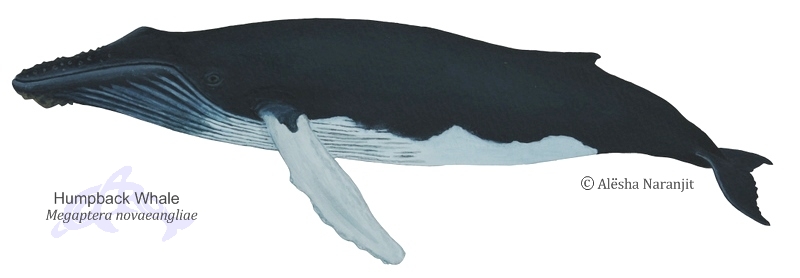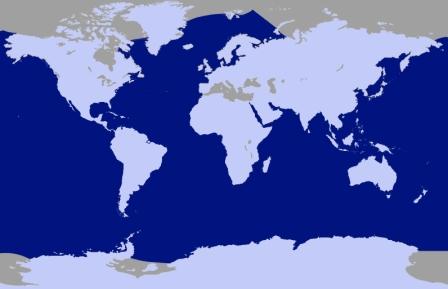
Classification Other Names: Hunchback Whale, Bunch, Hump Whale Suborder: Mysticeti Family: Balaenoptereridae | Description
|
Humpback Whale Ecology Range: From tropical to temparate oceans. Migrations occur annually from breeding to feeding grounds and back again. Usual group size: just mother and calf, sometimes groups of 12-15, often larger groups in feeding areas Main Diet: Small fish and krill Local population: Unknown. | Global range of the Humpback Whale  The dark blue areas indicate where Humpback Whales are likely to be found |
Conservation Information
Protection and Conservation Status
IUCN Conservation Status: Humpback Whales are listed as "Least Concern" on the IUCN red list. SPAW Protocol: Humpback Whales are cetaceans, which are listed under Annex II of the SPAW protocol. As such they require total protection under article 11 of this protocol which prohibits the "taking, possession, killing and commercial trade of the species, their parts or products". The SPAW protocol was created to help with the implementation and promotion of the Ramsar Convention and the Convention on Biological Diversity. The Annexes of the SPAW protocol can be found here. Local Laws: Cetaceans are protected under the Conservation of Wildlife Act of Trinidad and Tobago which offers protection to all species not listed under the second or third schedules of this act. |
Reports of Humpback Whales in Trinidad and Tobago
This is currently being researched and written. It will appear here shortly.
References
The above information was obtained from the following sources:
- A Princeton Field Guide: Whales Dolphins and Other Marine Mammals of the World by Hadoram Shirihai and Brett Jarrett (2006)
- Smithsonian Handbooks: Whales Dolphins and Porpoises by Mark Carwardine and illustrated by Martin Camm (2002)
- The Whale and Dolphin Conservation Society's Species Guide at http://www2.wdcs.org/species/index.php
- The IUCN Redlist at http://www.iucnredlist.org
- The SPAW protocol Annexes with links available at http://www.car-spaw-rac.org/?Annexes-of-the-SPAW-Protocol,83
Acknowledgements
We would like to thank the following people for the use of the art work and photographs:
- Alësha Naranjit (Illustration of Humpback Whale)